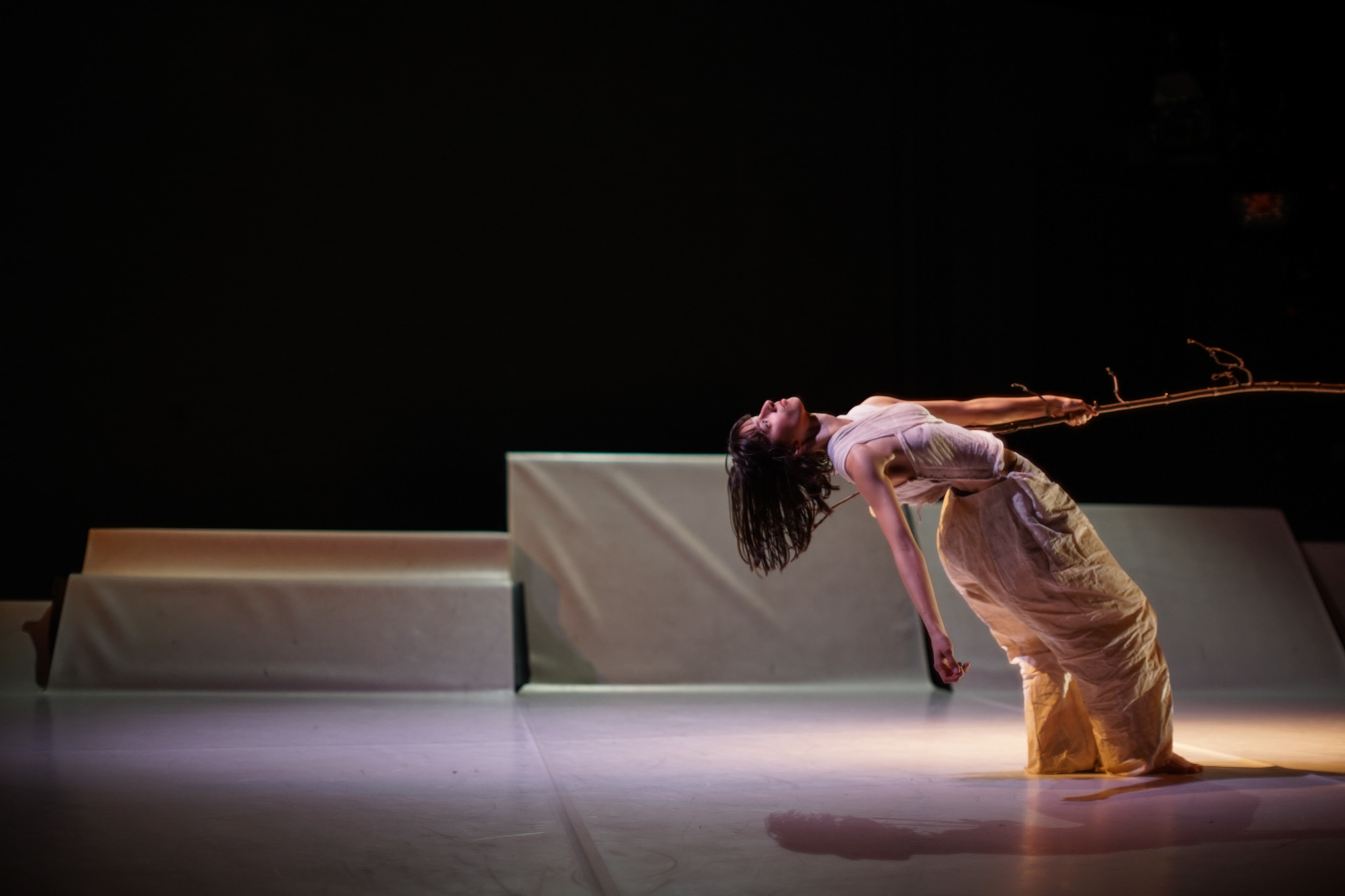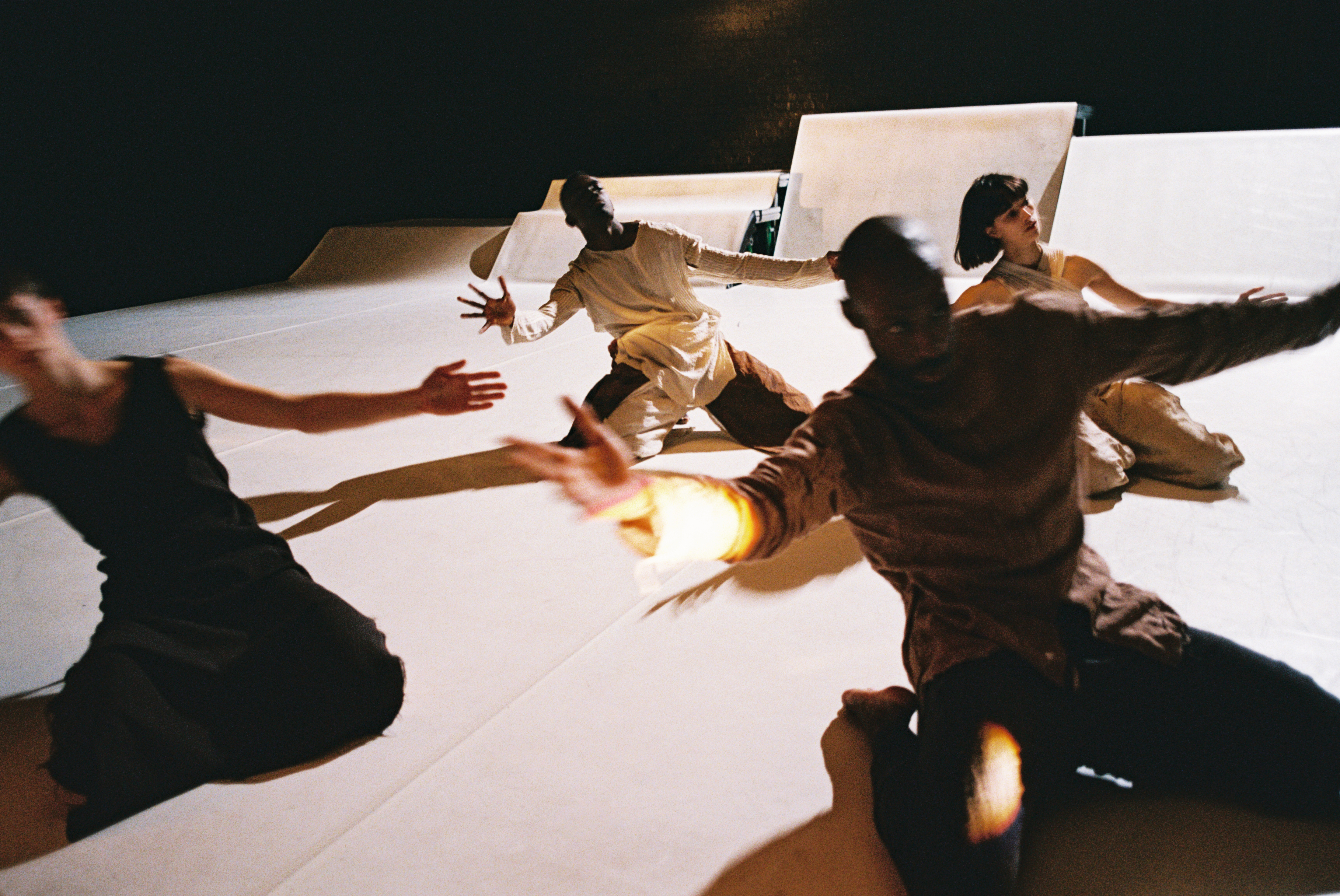Words by Maxine Flasher-Duzgunes. Watched at The Place, London.
“There is no activism without hope” said choreographer Sivan Rubinstein in the post-show talk, speaking of her piece Dance No 2° as a culmination of her climate research project with Generation Z students at King’s College London, China, and communities abroad. A tree branch, which began Sivan Rubinstein’s Dance No 2° that evening at The Place, London, teetered atop the head of dancer Lydia Walker as her body graciously allowed for its precarious up-falls and downfalls. Walker handled the weighty branch with a delicate sense of protest and then…an acquiescence, as if through its own unforeseen tilts, it demanded her movement more than its own.
The elevated slabs of marly at the back of the stage resembled a white desert plateau, like the remnants of a former sea floor run dry by wind. The branch’s instrumental lasso swoops coloured the airy soundscape and in its final stakes into the ground, the remaining three dancers’ slithery entrance painted a reptilian landscape. It was at first like seeing through the eyes of a creature oriented to the horizontal, and then to the storming crescendo of drums, the dancers’ long diagonal strides inverted us back to the vertical. Their loose khaki linens airbrushed them into nomads, lost mariners, like the tiny figurines inside sea captains’ bottled ships. Their dance became adagio-ed and worn down, a wafting current to the felt piano which played sparingly.
Later on, their upstage and downstage bursts progressed like airstreams, diverging and turbulent but then serendipitously condensed, to the smallest isolation of the ribcage and a stamp of the foot. Their stares out at us were of animals in survival mode, their humanity turned rugged as seemingly the last ones left there. A dichotomy emerged between a holistic peace with one another and the daunting revelation that it would all fall away in a second. During the post-show talk, Rubinstein argued for these blended extremes of “body as planet, and planet as home,” of concurrently creating and wasting energy, that have to be both the preservation and demise of our existence in an environmentally fluctuating terrain.

As the piece drifted from the landscape of the desert to that of the sea, dancer Harriet Parker-Beldeau decayed to a gnarled, embryonic state, her screeching like a form of suffocation until relieved by the sound score’s watery release. The antiquated crackles of water drops framed her solo, as if the dance could have been fed to us through a phonograph, its needle vibrating with the tides. And dancer Jordan Ajadi’s strayed running patterns seemed to trace the foamy pathways of departed dinghies in a shipyard, his weight constantly escaping itself through miles of corkscrewed pirouettes. If possible, the dancers were interchangeably sailors and the creatures who roamed underneath the sails. Dancer Nathan Goodman’s blend of razor-edged hiccup jumps with effortless splashes into the deep brilliantly shifted between the moment of float and the moment of sink. These divergences in movement were like distinct personal odysseys; the dancers were the captains of the chaos that raged around them and then, too, were the life preservers that saved them from drowning.
The voice of Kadeeshah, an 86-year-old woman whom Rubinstein met in the desert during her research initiative, resonated throughout the piece as the desert soul whose uncanny youth convinced us all of miracles. In one of the last segments when her projected image spanned the floor, her words conjured the incalculable feeling of moving to be moved, erasing what separates us from our intended destinations.
Dance No 2° reminded me of the stories my father used to tell me of his family’s weekend excursions to the Turkish side of the Black Sea — the high levels of minerals and salt would often cause him and his brother to float, and the absence of tides would create the serene effect of glass over the surface, like land crystalised upon sea. And it distilled time, their bodies suspended where neither land nor sea could be identified.
The idea of a desert sea explored in this piece pooled together the image of motionless saltwater with the endless spirals of the sands, and vice versa, the wild riptides of whirlpools with the static papyrus layout of arid wilderness. The dancers moved as if breathing in the water and swimming through the soil, suggesting a climate that one day — if not already — will have to accommodate for extremes.
Today can be an era of understanding ourselves as constellations on continents that are starting to move within and without the seasons. The dancers acted as these connecting points, as driftwood migrating over a map that can no longer split ocean from coast — an endangered species belonging to a country now undefined. It forced us as audience members to consider — as potentially the last of our kind on this earth — does movement across great distances result in refuge or peril? And can a home, if we dare to still call it that, sustain both?
Header image credit: Jurga Ramonaite.
Credits: A work by Sivan Rubinstein
Created with and performed by: Jordan Ajadi, Nathan Goodman, Harriet Parker-Beldeau, Lydia Walker
Composer: Liran Donin
Lighting Designer and Scenographer: Edward Saunders
Dramaturg: Xenia Aidonopoulou
Costume Designer: Olubiyi Thomas
Sound design, recording and mix: Gal Cohen
Community Performer & Voice Over: Aturah Kedeeshah Baht Israel
Film made in collaboration with: Bar Alon, Dror Shohet, Shai Skiff
Creative Producer: Lia Prentaki
Academic Partner: Dr. Sarah Fine
Mentor: Theresa Beattie
Access Support Worker: Lauryn Pinard
